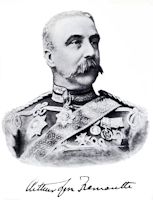3d May (Sunday).—I paid a long visit this morning to Mr Lynn the British Consul, who told me that he had great difficulty in communicating with the outer world, and had seen no British man-of-war since the Immortalité.
At 1.30 I saw Pyron’s regiment embark for Niblitt’s Bluff to meet Banks. This corps is now dismounted cavalry, and the procession was a droll one. First came eight or ten instruments braying discordantly, then an enormous Confederate flag, followed by about four hundred men moving by fours—dressed in every variety of costume, and armed with every variety of weapon; about sixty had Enfield rifles; the remainder carried shot-guns (fowling-pieces), carbines, or long rifles of a peculiar and antiquated manufacture. None had swords or bayonets—all had six-shooters and bowie knives. The men were a fine, determined-looking lot; and I saw amongst them a short stout boy of fourteen who had served through the Arizona campaign. I saw many of the soldiers take off their hats to the French priests, who seemed much respected in Galveston. This regiment is considered down here to be a very good one, and its colonel is spoken of as one of the bravest officers in the army. The regiment was to be harangued by Old Houston before it embarked.[1]
In getting into the cars to return to Houston I was nearly forced to step over the dead body of the horse shot by the soldier yesterday, and which the authorities had not thought necessary to remove.
I got back to General Scurry’s house at Houston at 4.30 P.m. The general took me out for a drive in his ambulance, and I saw innumerable negroes and negresses parading about the streets in the most outrageously grand costumes—silks, satins, crinolines, hats with feathers, lace mantles, &c, forming an absurd contrast to the simple dresses of their mistresses. Many were driving about in their masters’ carriages, or riding on horses which are often lent to them on Sunday afternoons; all seemed intensely happy and satisfied with themselves.
—— told me that old Sam Houston lived for several years amongst the Cherokee Indians, who used to call him “the Raven” or the “Big Drunk.” He married an Indian squaw when he was with them.
Colonel Ives, aide-de-camp to the President, has just arrived from Richmond, and he seems a very well-informed and agreeable man.
I have settled to take the route to Shrieveport tomorrow, as it seems doubtful whether Alexandria will or will not fall.
[1] At the outbreak of the war it was found very difficult to raise infantry in Texas, as no Texan walks a yard if he can help it. Many mounted regiments were therefore organised, and afterwards dismounted.



